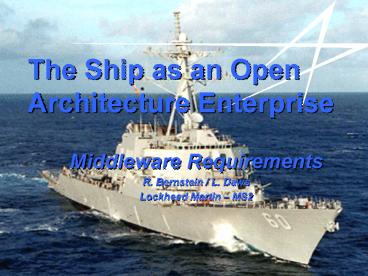Middleware Requirements PowerPoint PPT Presentation
1 / 17
Title: Middleware Requirements
1
The Ship as an Open Architecture Enterprise
- Middleware Requirements
- R. Bernstein / L. Daws
- Lockheed Martin MS2
2
Does This Idea Make Sense?
- Similarities of Ship to Enterprise
- Providing a valuable service at an affordable
cost - Depending on efficient information flow
- Customers, partners, suppliers
- Internal operations, information system
operations - Comprising stove-piped legacy systems working in
concert (often with difficulty) - Pushed by customer and business partners to
provide better interoperation - Attempting to keep up with technological change
- Always seeking lower-cost solutions
- Managed for best effectiveness like any other
system of people and equipment
3
A Warship Is Not A Typical Enterprise
- Employs myriad, open niche technologies
- Mechanical, electrical, communication, computing,
networking (many built only for military use) - Military sensors weapons
- Demands a broad range of performance
- Requires some level of high availability
robustness - Executes diverse changing missions
- Operates in adverse conditions far from a
maintenance facility - Carries people into harms way
4
Ship/Enterprise Common Problems
- Rapidly evolving underlying technology
- HW/System Architectural evolution
- OS Middleware complexity
- Increasing application functional complexity
- Interoperability with unforeseen systems
- Quality of Service (QoS) demands
- Sharp peaks in load
- 24x7 Availability
- Remote troubleshooting correction
A Modern Warship Exhibits These Same Requirements
5
Its an Organic System of Objects
- Radio Comms Links
- Electronic Warfare
Sensors
- Combat Info Center
Weapon Systems
HME Power and Propulsion
Computing Resources
- Crew
- Crew Services
Weapons Stores
Interconnect and Distribution Systems (Power,
Cabling, Water, Data, etc.)
6
Things to Model/Monitor/Control
- Hull, Mechanical Electrical Systems
- Crew Services
- Training
- Office automation
- Computing Resources
- Processing nodes
- Routers, switches
- Storage Media
- Software
- External Sensors
- Radars, Sonars, IFF, EWS
- Weapons
- Guns, Missiles, Torpedoes, Launch Systems
- Communication Gear
- Navigation Equip
- Motion, Depth, GPS
- Time Sources (GPS)
7
Uses of Information Aboard Ship
- Operations
- Safe navigation
- Mission planning execution
- Traffic monitoring (air, surface, subsurface)
- Threat detection, identification, evaluation
- Weapon engagement planning
- Weapon deployment and evaluation
- Readiness Maintenance
- Readiness testing (often online)
- Fault isolation, evaluation, repair
- Training
- Exercise crew in all operational scenarios
- Logging
- Record keeping of normal and combat actions
8
Real-Time Spectrum
Performance of the shipboard functions span
real-time spectrum
9
When Performance is Critical
- Performance Failures
- Control loop closure time not met
- Computer fails
- Network fails
- Consequence if not rectified
- Lose missile or miss target
- Lose ship!!!
- MISSILE CONTROL LOOPS
- Until missile is within self-guidance range
- Take radar measurement of planes position
- Compute missile guidance command
- Send missile guidance command
- While missile is in flight
- Collect missile health status
- Check for acceptable/safe performance
- If performance erroneous
- Destroy missile
System Failures Are Serious
10
Unfolding Future System Architecture Adapted
from DARPA IXO ARMS/PCES BAA Presentation, by
Doug C. Schmidt
The DoD envisions a new generation of embedded
system architectures technologies to
simultaneously control multiple quality of
service (QoS) properties improve software
development quality/productivity
Applications
Applications
Endsystem
Endsystem
11
Future Ship/Enterprise Architecture
- Embedded and Hard-Real-Time capabilities limited
to small portion of ships architecture - Number of capabilities are non-real-time in
nature - Provide for ease of continual update in war
fighter capabilities while minimizing need for
full system-level reintegration certification - No single level of performance requirements will
be applied to all shipboard capabilities - Uniform QoS across real-time spectrum
RT and Non RT Capabilities Must Interoperate
12
Middleware Requirements
- Data centric communications
- Many-to-Many data distribution
- Dynamic association
- Ability to provide receive data anonymously
- Reliable and Unreliable data transmission
- Scalability flexibility
- Security
- Authentication / password / id
- Multi-language support (C/Java)
13
Middleware Requirements (cont)
- Interoperability
- Cross language C / Java / Ada
- CORBA Java / JMS
- Cross vendor
- Deterministic behavior
- Latency while under load
- Resource utilization
- Resource management QoS control
- Access performance statistics and notification of
state / condition changes
14
Plans / Strategy
- Utilize commercial middleware capabilities
- Apply standards where they exist
- Influence development of new or existing
standards where they dont exist or inadequately
address needs - Leverage Publish / Subscribe design pattern and
capabilities to support middleware /
communication needs (i.e OMG DDS) - Adopt Model Driven Architecture (MDA) UML as
unifying modeling framework
15
Current Pub / Sub Developments
- Object Management Group
- Data Distribution Service (DDS) for Real-Time
Systems - OMG adopted final specification in May 2003
- DDS addresses RT and non-RT market needs
- Products soon to be available (early 2004)
- Following efforts of three vendors RTI, THALES
Naval Netherlands (Splice), and OIS - Java Community Process
- Java Messaging Service (JMS)
- Standardized by Java Community Process (JCP)
- JMS addresses commercial and internet markets
- Widely support
- Implemented over existing commercial pub/sub
products
16
Future Plans
- Conduct market survey / identify vendors and
products (JMS and DDS) - Identify products that support both RT and non-RT
applications - Assess standards
- Assess user base
- Identify feature / services support (security,
multi-language support, ) - Evaluation / Performance analysis
- Identify currently available benchmarks define
and develop new benchmarks - Work closely with customer
- Possible environments to perform evaluation
include Solaris, Linux/RT Linux, and LynxOS
17
Future Plans (cont)
- Additional area of investigation includes
bridging between JMS/Java and DDS - DDS support for Java
- Cross environment interoperability
- Cross vendor interoperability
- Work with standards organizations, vendors and
customer - Evaluation of existing future vendor
capabilities - Adherence to existing standards
- Promotion / development of new standards required
to meet future needs (CORBA MDA)

